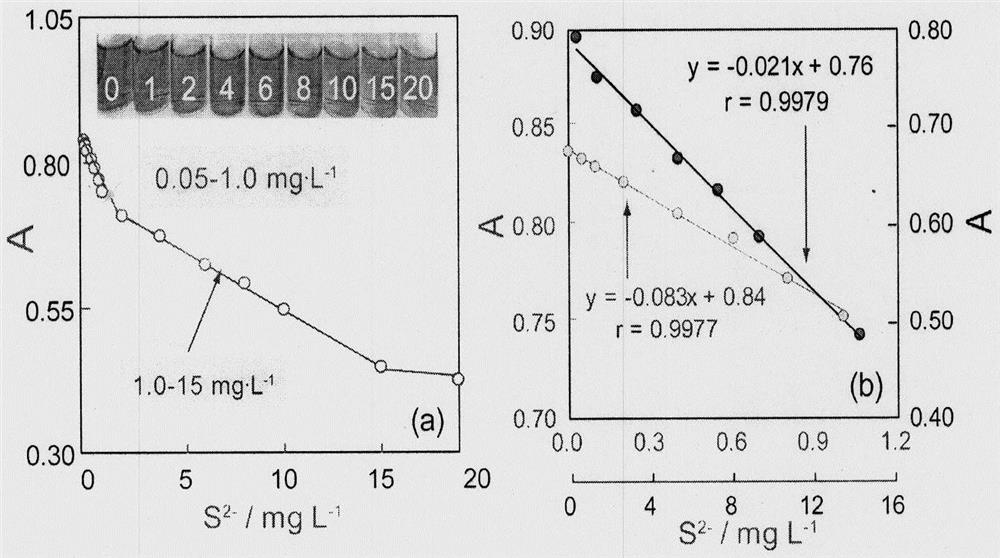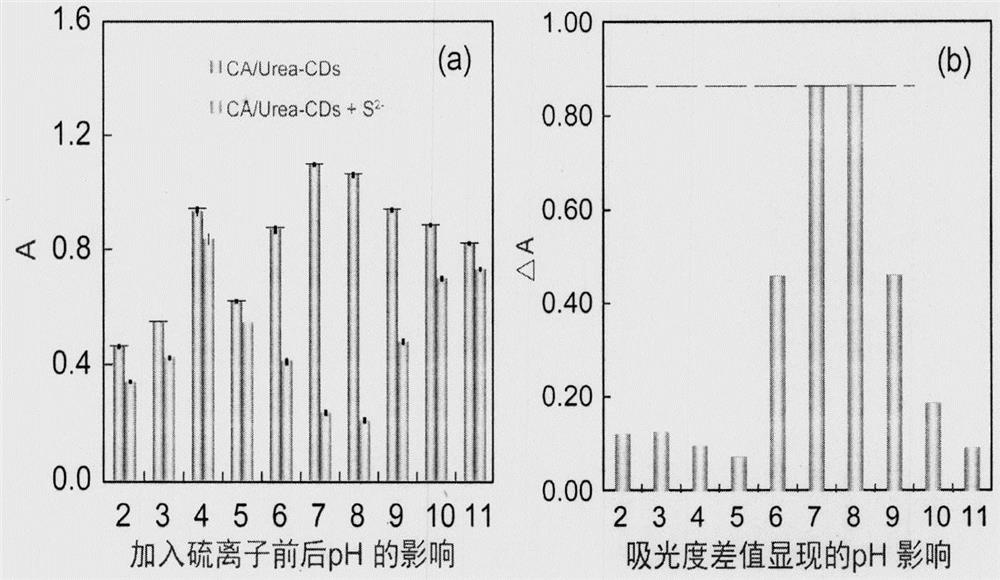System and device for automatically separating, enriching and detecting hydrogen sulfide in desulfurizing liquid and wastewater
A technology for automatic separation and desulfurization of liquid, applied in the direction of analysis of materials, color/spectral characteristic measurement, instruments, etc., can solve the problems of environmental pollution of color developer, complicated manual operation process, large error of measurement results, etc., to save resources, The effect of less dosage and easy operation of the device
- Summary
- Abstract
- Description
- Claims
- Application Information
AI Technical Summary
Problems solved by technology
Method used
Image
Examples
Embodiment 1
[0053] This example evaluates urea / CA-CDs and S 2- linear response between. figure 2 The curve shows that in the two ranges of 0.05~1.0 mg / L (A=-0.083c+0.84) and 1.0~15mg / L (A=-0.021c+0.76), S 2- exhibits a good linear correlation with the degree of extinction ( figure 2 b), when S 2- When the concentration reaches 15mg / L, the absorbance does not change any more. figure 2 The photographs in a also show that S 2- The concentration exhibited a good correlation with the color change of the carbon dots. The invention can meet the requirements of national waste water sulfide (0.856mg / L) or drinking water sulfide content (0.480mg / L) determination required by the World Health Organization; the invention can also be used for high-concentration sulfide determination through dilution.
Embodiment 2
[0055] This example evaluates the quantitative S of urea / CA-CDs 2- optimum acidity. The CDs concentration is set to 100mg / L; adjust the acidity of the reaction solution with PBS, 1mmol / L S 2- The standard solution was used as a test sample, and according to the absorbance values before and after the addition of CDs, the following results were obtained: image 3 The columnar curve shown. image 3 a shows that the pH of the reaction solution is different, and the CDs are replaced by S 2- The degree of fading also varies; image 3 b shows: when pH7~8, S 2- The degree of fading is maximized (maximum ΔA value). Because the reaction solution is easily affected by CO2 in the environment when the pH is 7, the pH is selected as 8.
Embodiment 3
[0057] In this embodiment, under the above-mentioned selected conditions, the effect of reaction temperature on urea / CA-CDs and S 2- The effect of fading reaction. The curve of the obtained absorbance difference versus temperature is shown in Figure 4 . Obviously, the CDs with S 2- The fading reaction system has the largest absorbance difference at room temperature (23-28°C), and the fading effect is the best. Therefore, using the assay of the present invention, S 2- , the temperature of the reaction system is selected within the room temperature range.
PUM
| Property | Measurement | Unit |
|---|---|---|
| The inside diameter of | aaaaa | aaaaa |
| Length | aaaaa | aaaaa |
Abstract
Description
Claims
Application Information
 Login to View More
Login to View More - R&D
- Intellectual Property
- Life Sciences
- Materials
- Tech Scout
- Unparalleled Data Quality
- Higher Quality Content
- 60% Fewer Hallucinations
Browse by: Latest US Patents, China's latest patents, Technical Efficacy Thesaurus, Application Domain, Technology Topic, Popular Technical Reports.
© 2025 PatSnap. All rights reserved.Legal|Privacy policy|Modern Slavery Act Transparency Statement|Sitemap|About US| Contact US: help@patsnap.com



